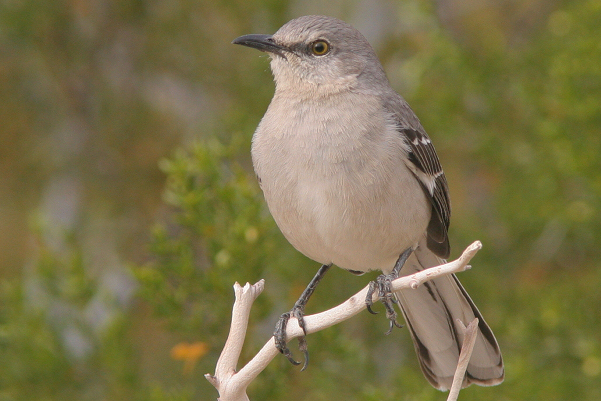
Date: 2005-12-17
Lens: Canon 300mm IS F4 + 1.4x II Converter

 Northern Mockingbird
Mimus Polyglottos
Northern Mockingbird
Mimus Polyglottos
 Description
Description
Do you remember the phrase "... mama's going to buy you a Mockingbird ..." from the childrens song Hush Little Baby? Because of their ability to sing a large variety songs, Mockingbirds were captured and sold as caged pets in the 18 and 19th centuries. This nearly caused their extinction in many places across the US. The Mockingbird has since recovered and can be seen all over San Diego, including Lake Murray.
These birds have the ability to mimic a large variety of songs from other birds as well as other sounds, such as insects, amphibians, car alarms, and mechanical sounds. Older, more experienced birds have the ability to sing up to 200 individual songs. It is said that their mimicing abilities are so accurate, that their songs are indistinguishable from the original, even in sonograms.
Mockingbirds are strong and aggressive defenders of their territory. They establish and defend a breeding territory in Spring. They have even been known to attack cats, dogs, humans, and other birds. In general, Mockingbirds mate for life. During the non-breeding season, they create and defend a feeding region. Their diet consists of berries, sumac, poison ivy, pokeberry, holy, and prickly pear.
Medium-sized bird with gray upperparts and light-gray/whitish underparts. Long black tail with white patches. Black wings with white patches that are distinctly visible during flight. Long thin bill and large brownish eye. Light colored eyestripe. Sexes similiar. 10 to 11 inches in length.
Residential areas, parks, desert brush, lakes, and open woodlands.
 Nesting
Nesting3-5 blue-green eggs with brown spots and a 12-13 day incubation period. Fledging occurs 11-13 days after hatching. The nest is an open cup made from sticks and weed stems, located in a bush or low tree.